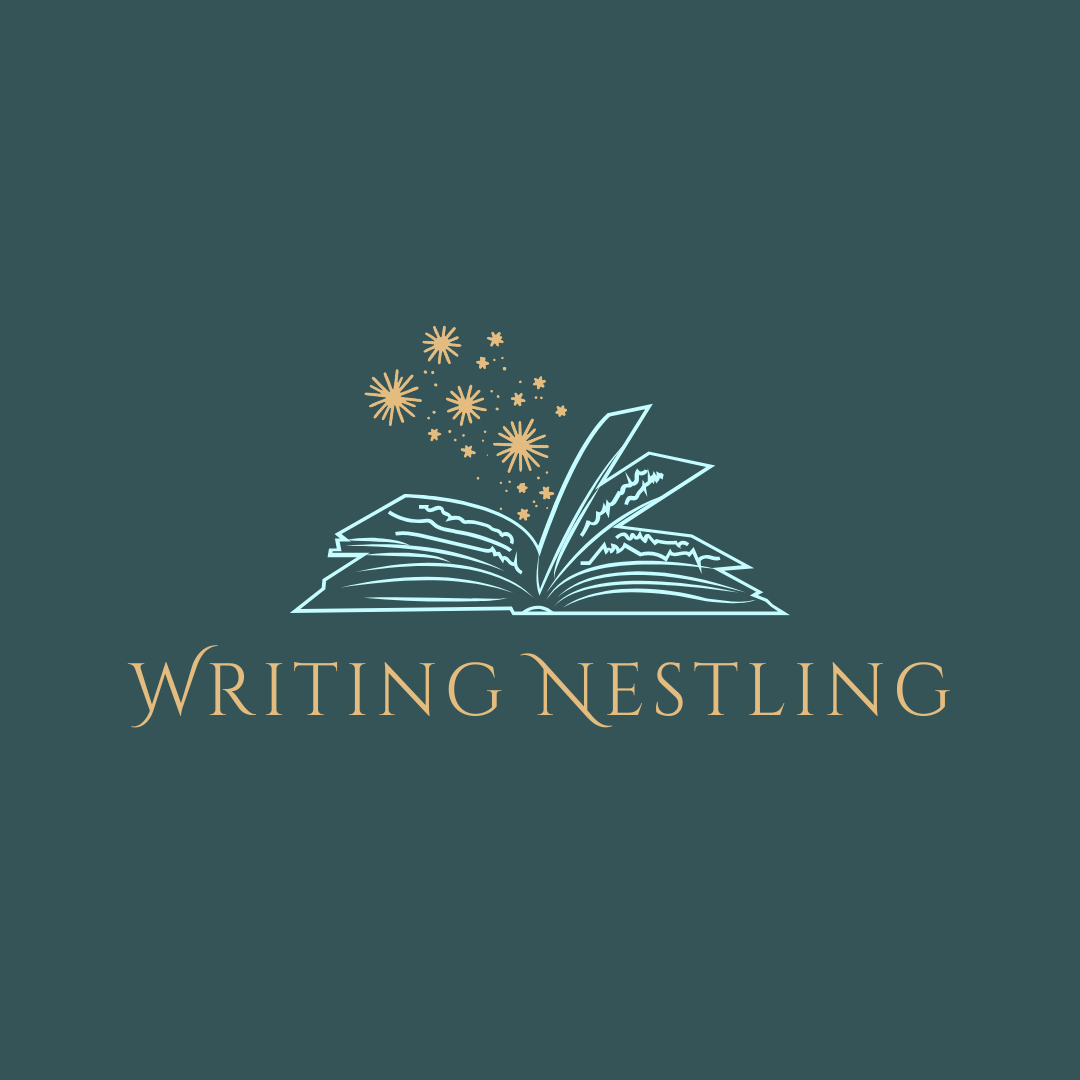
Writing Nestling


How To Describe Autumn Season In Writing (11 Steps, Quotes & Words)
Table of Contents
How To Describe Autumn Season In Writing
How To Describe Autumn Season In Writing: Welcome to the art of capturing the vivid essence of autumn with the stroke of your pen and the magic of your words.
The autumn season, with its rich tapestry of colors, crisp air, and the subtle symphony of falling leaves, has long been an inspiration for writers seeking to evoke the very essence of change, nostalgia, and natural beauty.
Whether you are crafting a novel, a poem, or simply seeking to infuse your prose with the spirit of this transformative season, this guide will be your compass through the labyrinth of autumn’s sensory riches.
Join us as we embark on a journey to explore the spectrum of autumn’s colors, the evocative imagery, the emotions it stirs, and the literary devices that will help you capture the heart of this enchanting season in your writing.
Prepare to immerse yourself in the world of autumn, where every word becomes a brushstroke on the canvas of the reader’s imagination.
Here’s a step by step process on How To Describe Autumn Season In Writing:
Observation
Start by closely observing your surroundings during the autumn season. Take note of the colors, sounds, smells, and textures that define this season.
Choose a Setting
Decide on the setting you want to describe. It could be a forest, park, cityscape, or any other location that captures the essence of autumn for you.
Engage the Senses
Describe what you see, hear, smell, taste, and touch. Use vivid and sensory language to paint a picture of the autumn scene. For example:
Visual: Mention the vibrant red, orange, and yellow leaves falling from the trees. Auditory: Describe the rustling of leaves in the wind or the honking of geese migrating south. Olfactory: Mention the crisp scent of fallen leaves or the aroma of pumpkin spice. Gustatory: Share the taste of freshly baked apple pie or pumpkin-flavored treats. Tactile: Describe the cool, crisp air on your skin or the sensation of walking on crunchy leaves. Emotions and Mood: Reflect on the emotions and mood associated with autumn. It’s a season of change, nostalgia, and transition. Capture these feelings in your description.
Metaphors and Similes
Use metaphors and similes to enhance your description. For instance, you might compare the falling leaves to a golden rain shower or the colors of the trees to a painter’s palette.
Seasonal Activities
Mention typical autumn activities, such as apple picking, Halloween, or Thanksgiving, to create a sense of time and place.
Weather and Climate
Discuss the weather conditions in autumn, like cooler temperatures, occasional rain, or the first frost of the season.
Wildlife and Nature
Include references to wildlife that is active during autumn, such as squirrels collecting acorns or birds migrating south.
Cultural References
Incorporate cultural references or traditions associated with autumn, like harvest festivals or the changing of the clocks for daylight saving time.
Personal Connection
Share your personal connection or memories associated with autumn, which can make your description more relatable and heartfelt.
Structure and Flow
Organize your description in a logical and coherent manner. Consider using a chronological or thematic structure to guide your reader through the season.
Editing and Revision
After writing your description , review and edit it for clarity, conciseness, and evocative language. Ensure that your writing effectively conveys the beauty and essence of autumn.
By following these steps, you can create a compelling and vivid description of the autumn season that engages your readers’ senses and emotions.
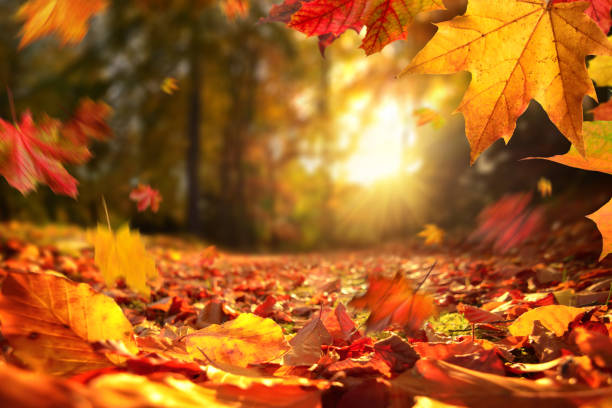
Quotes About Autumn Season
Certainly! Here are some quotes that capture the essence of the autumn season:
“Autumn carries more gold in its pocket than all the other seasons.” – Jim Bishop
“Every leaf speaks bliss to me, fluttering from the autumn tree.” – Emily Brontë
“Autumn is a second spring when every leaf is a flower.” – Albert Camus
“Delicious autumn! My very soul is wedded to it, and if I were a bird I would fly about the earth seeking the successive autumns.” – George Eliot
“Fall has always been my favorite season. The time when everything bursts with its last beauty, as if nature had been saving up all year for the grand finale.” – Lauren DeStefano
Descriptive Words For Autumn Season
Certainly! Here are 10 descriptive words for the autumn season:
Crisp Golden Rustic Mellow Auburn Fragrant Majestic Tranquil Chilly Vibrant
These words aim to capture the vivid imagery, sensory experiences, and emotional nuances associated with the autumn season.
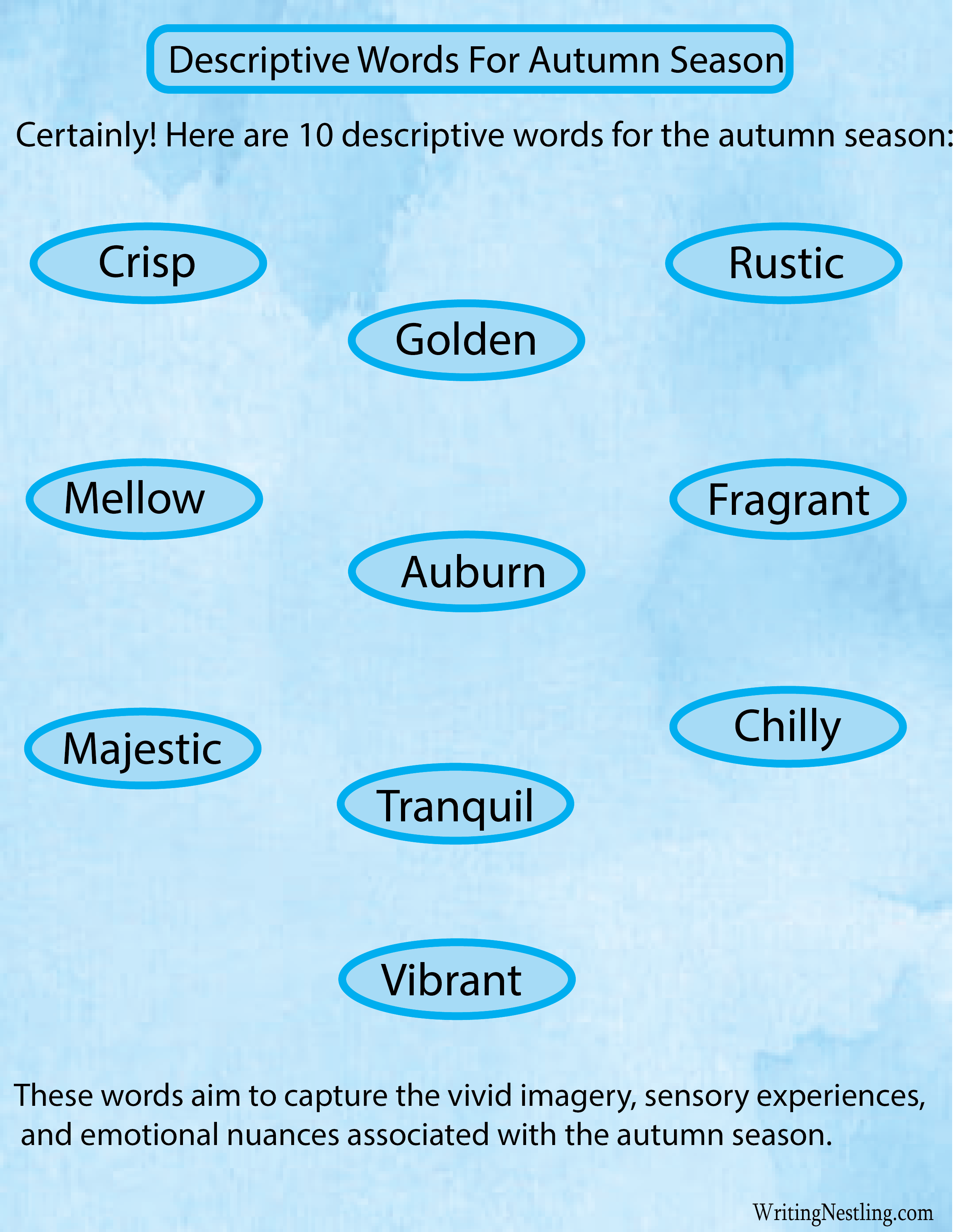
Understanding Autumn’s Palette
Understanding Autumn’s Palette is like deciphering the secrets of a painter’s masterpiece – each stroke of nature’s brush transforms the canvas of our world into a symphony of fiery reds and oranges, earthy browns and yellows, and deep greens fading into olive.
It’s a visual orchestration, where passion and warmth burst forth in vibrant hues, where maturity and harvest are whispered through the subtle variations of brown and yellow, and where the transition of seasons is celebrated with the resilient green and olive tones.
This palette, like the changing leaves themselves, tells a story of life’s eternal cycle, inviting us to explore its depths and paint our own narratives with the vivid colors of autumn.
The spectrum of autumn colors
The spectrum of autumn colors is a mesmerizing kaleidoscope that nature unveils with each passing day. As summer gracefully yields to the cooler embrace of fall, we witness a breathtaking transformation in the landscape.
Fiery reds and oranges set ablaze the leaves of maples and oaks, like a thousand embers igniting the forest. Earthy browns and yellows paint the world with the wisdom of age, as trees prepare for their winter slumber.
Meanwhile, deep greens gracefully fade into subtle olive tones, a testament to the season’s transitional nature. This spectrum of colors is not just a visual delight but a poetic reminder of life’s impermanence and the beauty in letting go.
Symbolism of autumn hues
The symbolism of autumn hues runs deep, transcending mere visual beauty to encompass profound emotions and metaphors.
The fiery reds and oranges of autumn leaves symbolize passion, warmth, and the intensity of life’s fleeting moments.
These colors evoke a sense of urgency, reminding us to savor the present. Earthy browns and yellows represent maturity and the bountiful harvest, signifying the culmination of hard work and growth.
They remind us of the rewards that come from patience and diligence. Deep greens transitioning into olive hues mirror life’s adaptability and resilience in the face of change, underscoring the cyclical nature of existence.
Autumn’s colors, like the chapters of life, tell a story of transformation, harvest, and renewal, inviting us to reflect on the profound symbolism hidden within their hues.
Sights and Sounds of Autumn
In the enchanting symphony of autumn, the sights and sounds harmonize like a timeless melody. As the leaves don their vibrant coats of red, orange, and gold, they dance in the crisp breeze before descending to the earth with a soft, rustling cadence, a delicate percussion of nature’s own making.
The skies above are a canvas of clarity, where the sun casts a warm, golden glow upon the world, and geese soar southward, their honks a poignant reminder of the season’s migration.
Harvested fields stretch as far as the eye can see, a patchwork quilt of earthy colors that radiate the abundance of the season.
And amidst it all, the bonfires crackle and pop, sending fragrant tendrils of woodsmoke into the air, completing the sensory tapestry of autumn’s embrace.
This season is a masterpiece of sensory delight, where every sight and sound weaves together to create a breathtaking symphony that resonates deep within the soul.
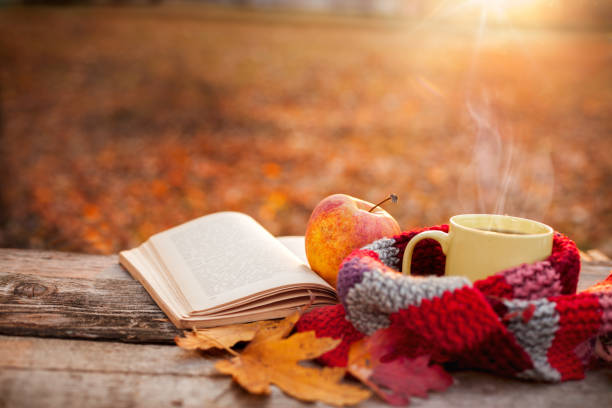
Visual descriptions
Visual descriptions in autumn are like stepping into a vivid dreamworld painted by nature’s hand. The changing foliage transforms the landscape into a breathtaking panorama of fiery reds, burnt oranges, and golden yellows.
Each tree becomes a unique work of art, its leaves a testament to the passage of time. Falling leaves cascade like confetti from the heavens, creating a whimsical ballet of colors against the backdrop of a clear, azure sky.
Harvested fields stretch out in a patchwork quilt, a testament to the labor and bounty of the season. Every detail, from the glistening dew on spiderwebs to the ethereal mist rising from serene lakes, adds layers of enchantment to this visual tapestry.
In autumn, the world becomes an exquisite painting, and every gaze is an opportunity to lose oneself in the sheer beauty of the season.
Auditory imagery
Autumn’s auditory imagery is a symphony for the senses, where the world seems to whisper its secrets. The rustling leaves, borne on a gentle breeze, create a soothing chorus as they fall to the earth, their crisp sounds a reminder of the season’s impermanence.
Whistling winds sweep through the trees, their haunting melodies carrying with them the essence of change. Crackling bonfires provide the rhythmic heartbeat of cozy gatherings, each pop and hiss an invitation to gather closer.
And above it all, the honking of geese as they migrate southward serves as a poignant reminder of nature’s cycles.
In autumn, the world is alive with sounds that stir the soul, inviting us to listen closely and embrace the enchanting melodies of the season.
Embracing Autumn’s Aromas
Embracing autumn’s aromas is like stepping into a fragrant tapestry woven with the essence of nostalgia and comfort.
The air carries the scent of fallen leaves, damp and earthy, a reminder of nature’s ever-turning cycle. Fragrant spices like cinnamon and nutmeg infuse the atmosphere with warmth, as if the very soul of the season is distilled in every waft of baked goods and steaming beverages.
Roasting chestnuts add a toasty note to the crisp air, conjuring images of cozy firesides and gatherings of old friends. And the sweet, tantalizing aroma of freshly baked apple pies and pumpkin spice lattes envelops the senses, beckoning us to indulge in the flavors of the season.
Autumn’s aromas are a symphony of comfort and nostalgia, an invitation to savor the simple pleasures of life, and a reminder that beauty can be found even in the air we breathe.
Texture and Touch
The textures of autumn are a tactile delight, inviting you to reach out and connect with the world in a deeply sensory way.
It’s the crispness of the air that tingles on your skin, carrying the promise of cozy evenings and chilly adventures.
It’s the satisfying crunch of leaves underfoot, each step a testament to the season’s transformation. As you wrap yourself in a warm, knitted sweater, you can feel the embrace of autumn’s cool breeze, a reminder that nature herself is preparing for a peaceful slumber.
Running your fingers over the smooth bark of a tree, you sense the wisdom and resilience of the natural world, reminding you that change is a beautiful and essential part of life.
Autumn is a season to be touched and felt, a reminder that the world around us is as alive as we are, and that every sensation is an invitation to embrace its beauty.

Crispness in the air
The crispness in the air during autumn is like nature’s whispered promise of transformation. It’s a tangible, invigorating sensation that fills your lungs as you step outside, awakening your senses to the changing season.
The air, cool and clean, carries a hint of impending frost and the promise of cozy evenings by the fireplace. It tingles against your skin, reminding you of the fleeting warmth of summer and the forthcoming embrace of winter.
With each inhale, you can almost taste the earthiness of fallen leaves and the anticipation of holidays on the horizon.
Crispness in the air is nature’s way of saying, “Change is here,” and it’s an invitation to savor every breath, relishing the beauty of autumn’s arrival.
Crunching leaves underfoot
Crunching leaves underfoot is a joyful, rhythmic symphony of autumn, a simple act that connects us deeply with the season’s essence.
As your feet press down on the carpet of fallen foliage, a satisfying and satisfyingly crisp sound resonates beneath you, like nature applauding your presence.
It’s a tactile experience that awakens a childlike delight, invoking memories of carefree days spent kicking through piles of leaves. The scent released with each step carries the earthy essence of the season, a reminder that life is in constant transition.
Crunching leaves underfoot is an invitation to be fully present, to revel in the tangible beauty of the world, and to celebrate the small, delightful moments that make autumn such a cherished time of year.

The warmth of a cozy sweater
The warmth of a cozy sweater in autumn is like a comforting embrace from an old friend. As you slip into its soft, knitted fabric, you immediately feel cocooned in a sense of security and well-being.
The sweater, like a loyal companion, shields you from the brisk chill in the air, wrapping you in a gentle, reassuring hug.
Its familiarity is a source of comfort, evoking memories of past autumns and the promise of more to come. It’s a piece of clothing that not only keeps you physically warm but also warms your heart with its embodiment of seasonal coziness.
The warmth of a cozy sweater is an invitation to slow down, savor the moment, and relish the simple pleasures of autumn’s embrace.
Evoking Emotions
Evoking emotions is the alchemy of words and imagery, the art of capturing the intangible essence of the human experience. In the tapestry of autumn’s colors, there is nostalgia for the fading warmth of summer, a bittersweet farewell.
There’s awe, as the grandeur of nature unfolds, leaves ablaze with passion. But there’s also the melancholy of falling leaves, a poignant reminder of life’s transience.
And within the cozy comforts of the season, there’s a profound sense of security and contentment, like being wrapped in a warm embrace.
Emotions in autumn are like leaves in the wind, swirling and shifting, inviting us to embrace the complexity of our feelings, reminding us that within every season, there is a spectrum of sentiment waiting to be explored and expressed.
Nostalgia for summer’s end
Nostalgia for summer’s end is like a gentle ache for a chapter closing in the book of time. As the days grow shorter and the air cools, there’s a wistful longing for the sun-kissed moments, the laughter, and the freedom that summer brought.
It’s the yearning for barefoot strolls on warm sands and the taste of ice cream that melts faster than memories. The nostalgia is a reminder that nothing lasts forever, that the carefree days of summer are ephemeral, and that life’s beauty lies in its impermanence.
It’s a bittersweet embrace of change, a recognition that, like the changing leaves, we too must let go and make way for the next season, even as we hold on to the cherished memories of summer’s vibrant warmth.
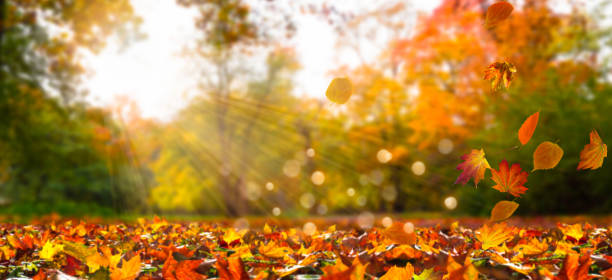
The melancholy of falling leaves
The melancholy of falling leaves is a poignant reminder of nature’s cycles and the inevitability of change. As these vibrant, once-green emblems of life gently drift to the ground, there’s a sense of graceful surrender in their descent.
It’s as if they carry with them the collective weight of countless seasons, whispering tales of growth, maturity, and ultimate release.
The rustling of leaves underfoot is a melancholic lullaby, and the sight of bare branches against the sky evokes a sense of loss.
Yet, in this melancholy, there’s also a quiet beauty—a poignant reminder that endings are often the prelude to new beginnings. It’s a reminder to embrace the impermanence of life and find solace in the elegance of nature’s constant transformation.
Cozy comfort in autumn’s embrace
Cozy comfort in autumn’s embrace is like being enveloped in a warm, fuzzy blanket of contentment. It’s the feeling of sinking into a plush armchair by a crackling fire, a hot cup of spiced tea in hand, while the rain taps a soothing melody on the windowpane.
It’s the soft glow of candlelight casting dancing shadows on the walls, and the scent of cinnamon and apples wafting through the air.
Autumn’s embrace wraps around you like the embrace of an old friend, offering respite from the hustle of life and inviting you to slow down.
It’s a time to nestle deeper into your favorite sweater, share stories with loved ones, and savor the simple pleasures of life.
In this season, comfort is not just a sensation; it’s a state of mind, a reminder that sometimes, the most precious moments are found in the quiet embrace of the present.
Crafting Engaging Metaphors and Similes
Crafting engaging metaphors and similes is akin to weaving threads of magic into the fabric of your writing. Like a skilled sorcerer, you summon unexpected connections that dance across the reader’s imagination, breathing life into your words.
Metaphors are the portals through which abstract ideas manifest as tangible, relatable images, while similes are the sparkling gems that light up your prose with vivid comparisons.
They are the kaleidoscope of literary devices, where the ordinary becomes extraordinary, the mundane takes on new dimensions, and the complex is distilled into the familiar.
Crafting metaphors and similes is not merely an exercise in linguistic dexterity; it’s an invitation to paint with the colors of emotion, to sculpt with the clay of perception, and to transport your readers to realms they never knew existed within the confines of your words.
In the world of writing, metaphors and similes are the keys to unlocking the door to wonder, and in their magic, we find the true artistry of language.
Literary Devices and Techniques
Literary devices and techniques are the secret tools of a writer’s trade, the shimmering jewels in the crown of storytelling.
They’re the symphony’s crescendo, the painter’s brushstroke, and the architect’s blueprint all rolled into one. Through these devices, a writer transforms mere words into a captivating dance of emotions, ideas, and imagery.
Metaphors and similes paint vivid pictures; personification breathes life into inanimate objects; symbolism weaves deeper meanings into the narrative fabric; and foreshadowing casts shadows of anticipation.
These devices are not mere flourishes; they are the architects of suspense, the alchemists of emotion, and the architects of meaning.
In the hands of a skilled writer, literary devices and techniques become the keystones of literary marvels, the wings of flights of fancy, and the invisible threads that tie readers to the heart and soul of a story .
Imagery and sensory details
Imagery and sensory details are the vibrant pigments on a writer’s palette, the tools that breathe life into the canvas of words. They are the brushes that paint vivid scenes in the reader’s mind and the symphony that resonates through the prose.
Through evocative imagery, the writer can transport readers to far-off lands with the scent of exotic spices, immerse them in a torrential downpour that leaves them drenched, or make them feel the warmth of a crackling fire on a cold winter’s night.
Sensory details awaken the senses, allowing readers to taste the tang of a ripe apple, feel the rough texture of weathered wood, or hear the gentle rustling of leaves in the wind.
By masterfully weaving these elements into the narrative, a writer transforms words into an immersive experience, allowing readers to not just read but to feel, see, hear, taste, and smell the world they’ve crafted, forging a deep and lasting connection between writer and reader.
Personification of autumn elements
Personification of autumn elements is like granting nature the gift of speech, inviting the season to tell its own story.
It’s the rustling leaves conspiring in a whispered secret, the winds serenading with their mournful melodies, and the sun winking mischievously as it dips below the horizon.
Through personification, autumn becomes a character in its own right, its elements taking on human qualities, desires, and emotions.
The trees may lament the loss of their leaves, the breeze may caress your cheek with a gentle touch, and the harvest may proudly parade its bounty.
In this literary dance, nature becomes a storyteller, speaking to us in the language of the human experience, and offering us a deeper connection with the ever-changing world around us.
The role of foreshadowing
The role of foreshadowing in storytelling is akin to a masterful magician’s sleight of hand, subtly guiding the audience toward what lies ahead while still maintaining an air of mystery.
It’s the delicate art of dropping breadcrumbs of anticipation throughout the narrative, hinting at future twists and revelations. Foreshadowing is the author’s way of inviting readers into a deeper engagement with the story, allowing them to participate actively in the unraveling of its secrets.
It creates a sense of inevitability, where readers feel the impending significance of events long before they occur, intensifying the emotional impact when they finally do.
In essence, foreshadowing is the storyteller’s promise that every element, every subplot, and every character serves a purpose in the grand tapestry of the narrative, ensuring that no detail is without meaning and no resolution comes without a sense of fulfillment.
The Power of Analogies
The power of analogies is like wielding a literary scalpel, delicately dissecting complex ideas and grafting them onto the reader’s understanding.
Analogies are the bridges between the known and the unknown, the keys that unlock comprehension in even the most abstract of concepts.
They’re the poetic revelations that liken the intangible to the tangible, revealing hidden connections and patterns in the vast tapestry of knowledge.
Analogies are the compasses that guide us through the labyrinthine corridors of understanding, allowing us to navigate uncharted territories with the familiarity of the known.
In their elegant simplicity, they illuminate the profound, making the complex accessible and the unfamiliar relatable.
Through analogies, the writer becomes an architect of understanding, constructing bridges of insight that invite readers to traverse the vast landscapes of ideas with clarity and newfound wisdom.
Comparing autumn to life cycles
Comparing autumn to life cycles is like unraveling the profound wisdom hidden within the changing of seasons.
Autumn, with its vibrant colors and falling leaves, mirrors the stages of life with remarkable clarity. It represents the twilight of existence, where the brilliance of youth and summer’s vitality gracefully gives way to the wisdom of maturity and the acceptance of impermanence.
Just as trees shed their leaves in autumn, humans release the burdens of their past, letting go of what no longer serves them.
It’s a reminder that life is a continuous journey of transformation, and that, like the seasons, we too must embrace change and find beauty in every stage.
In autumn, the cycle of life is unveiled, and its reflection in nature offers solace, reminding us that even as we age, we can still blaze with the fiery hues of purpose and meaning.

Relating autumn to human emotions
Relating autumn to human emotions is akin to a soulful symphony where the heartstrings of both nature and humanity are delicately intertwined.
As the leaves burst into fiery reds and oranges, there’s a passionate intensity that mirrors the warmth of love and the fervor of desire. Yet, as they fall gracefully to the ground, there’s a poignant melancholy akin to the nostalgia and acceptance that often accompany the passage of time.
The crisp, cool air elicits a sense of invigoration and reflection, much like the emotions that arise in moments of change and self-discovery.
Autumn encapsulates the full spectrum of human feelings, from the warmth of connection to the bitter sweetness of farewells, inviting us to connect with our own emotions and the profound beauty of the natural world in a harmonious dance of sentiment and scenery.
Exercises and Writing Prompts
Exercises and writing prompts are the artist’s tools in the grand atelier of creativity, each one a brushstroke on the canvas of your imagination. They are the gymnasiums for your writer’s muscles, where you flex your literary brawn and train your mind to leap beyond the mundane.
These exercises are the treasure maps leading to uncharted literary territories, where you uncover the gems of your own unique voice and storytelling style.
Writing prompts are like the magical keys that unlock the doors to infinite worlds, igniting the sparks of inspiration that can set your creativity ablaze.
They are the enchanting spells that summon your muse, inviting her to dance with your words.
In the realm of writing exercises and prompts, the journey becomes the destination, and each exercise is a stepping stone towards your own literary masterpiece, reminding you that the joy of writing is not just in the destination but in the exploration of your own creative landscape.

Frequently Asked Questions (FAQ) about How To Describe Autumn Season In Writing
What is the best way to start describing the autumn season in writing.
To begin describing the autumn season, start by closely observing your surroundings and noting the sensory details, such as colors, sounds, smells, and textures, that define this season.
Can you provide some examples of sensory descriptions for autumn?
Certainly! Here are a few examples:
Visual: “The trees were ablaze with vibrant red and orange leaves.” Auditory: “The leaves rustled in the gentle autumn breeze.” Olfactory: “The air was filled with the crisp scent of fallen leaves.” Gustatory: “I savored the taste of warm apple cider on a chilly autumn evening.” Tactile: “Walking on the crunchy carpet of fallen leaves was a delight.”
How can I convey the emotions and mood of autumn in my writing?
You can convey the emotions and mood of autumn by focusing on themes of change, nostalgia, and transition. Describe how the season makes you feel and how it impacts the atmosphere.
What literary devices can I use to enhance my description of autumn?
Metaphors and similes work well. For example, you can compare the falling leaves to a golden rain shower or the colors of trees to a painter’s palette. These devices add depth and vividness to your writing.
Should I include seasonal activities in my description of autumn?
Yes, mentioning seasonal activities like apple picking, Halloween, or Thanksgiving can help create a sense of time and place in your description.
What are some common weather characteristics of autumn that I should mention in my writing?
In autumn, you can mention cooler temperatures, occasional rain, the first frost, or the crispness of the air. These weather details contribute to the overall atmosphere of the season.
Is it important to incorporate cultural references in my description of autumn?
Including cultural references or traditions associated with autumn, such as harvest festivals or the changing of the clocks for daylight saving time, can add depth and relatability to your description.
Should I share personal anecdotes or memories related to autumn in my writing?
Sharing personal anecdotes or memories can make your description more relatable and heartfelt. It allows you to connect with your readers on a personal level.
How should I structure my description of the autumn season?
You can structure your description chronologically, starting with the early signs of autumn and progressing through the season, or thematically, focusing on different aspects like colors, nature, or emotions associated with autumn.
What should I do after writing my description of autumn?
After writing, be sure to review and edit your work for clarity, conciseness, and evocative language. Make sure your writing effectively conveys the beauty and essence of autumn to your readers.
In the conclusion of How To Describe Autumn Season In Writing, we have unraveled the intricate threads that compose this season’s rich tapestry.
We’ve delved into the vibrant palette of colors, embraced the sensory symphony of autumn’s sights, sounds, and scents, and explored the deep well of emotions it stirs within us.
We’ve harnessed the power of literary devices and techniques, crafting metaphors, similes, and personifications that breathe life into our prose.
As we conclude this journey, remember that describing autumn is not just an exercise in observation, but an invitation to connect with the world and our readers on a profound level. Autumn is a mirror reflecting the beauty of transformation and the cyclical nature of life.
So, as you pen your final words about this enchanting season, allow your writing to resonate with the timeless rhythms of autumn, and may your words, like falling leaves, touch the hearts and souls of your readers, leaving them forever captivated by the magic of the season.
Related Posts:
- How To Describe Summer Season In Writing (08 Best Steps)
- How to Describe Spring Season in Writing (08 Best Tips)
- How To Describe A Forest In A Story (For Beginners In 2024)
- How To Describe Winter Season In Writing (12 Best…
- How To Describe A River In Writing (10 Best Ways)
- How To Describe A Lake In Writing (11 Best Ways You…
Similar Posts

How To Describe A Lake In Writing (11 Best Ways You Need To Know)
How To Describe A Lake In Writing How To Describe A Lake In Writing: Embarking on the journey of describing a lake in writing is akin to unlocking the gates to a realm where words become brushstrokes, and sentences weave a tapestry of nature’s beauty. It is an art that transcends mere depiction, inviting writers…

How To Write Country Music For Beginners 2024
How To Write Country Music How To Write Country Music: In the soulful depths of country music lies a rich tapestry of storytelling, melody, and emotion that has captured the hearts of listeners for generations. It’s a genre steeped in tradition yet constantly evolving, where the timeless themes of love, loss, and the rugged beauty…

How To Describe Foreshadow Death In Writing (13 Best Ways)
How To Describe Foreshadow Death In Writing How To Describe Foreshadow Death In Writing: Foreshadowing death in writing is a powerful literary tool that allows authors to weave anticipation, suspense, and emotional resonance into their narratives. It is the art of providing subtle hints and clues that prepare the reader for the impending demise of…

How To Describe Love In Writing (For Beginners in 2024)
How To Describe Love In Writing How To Describe Love In Writing: Describing love in writing is a captivating and profound endeavor that transcends the limitations of mere words. Love, that enigmatic and universal emotion, is both a muse and a challenge for writers across the ages. It dances through the pages of literature, painting…

How To Describe A Rich Person In Writing (10 Best Tips, Words &Phrases)
How To Describe A Rich Person In Writing How To Describe A Rich Person In Writing: Describing a rich person in writing is akin to capturing the essence of opulence and privilege with the stroke of a pen. It’s a literary endeavor that goes beyond the superficial trappings of wealth, delving into the complexities of…

How to Use the 3-Act Story Structure In 2024
How to Use the 3-Act Story Structure Introduction to the 3-Act Story Structure Humans have been telling stories through communication for thousands of years. Every great story has a framework that guides the plot and gives it a sense of flow and rhythm. The three-act story structure is one of the oldest and most frequently…

Obsessed With Learning
Helping Teachers Get Their Lives Back

Descriptive Writing in the Fall
It’s no secret that autumn is our absolute favorite season. With the explosive colors abounding on the trees, the crisp and clean air whipping around, and the chilling temperatures, it just makes us want to snuggle in our coziest hoodie while watching a crackling fire. This makes it the perfect time to explore descriptive writing in the fall.
This week, I taught one of my middle school classes how to write a descriptive essay about fall. A descriptive essay is a written account describing something or an experience. At first, it may feel like something you don’t have to put much time into teaching. Just throw in some adjectives and you’re good to go! Yet, there’s more to it than that.
Let’s dive into how I taught descriptive writing during the fall this past week.

Pre-Writing
As part of the pre-writing activities, we first spent time learning various figurative language. We explored examples of each of the following: similes, metaphors, idioms, allusion, alliteration, personification, and onomatopoeia. Students identified each of the figurative language terms within writing and then they did the work of explaining the meaning behind each of the examples.
Next, they wrote their own similes, metaphors, idioms, etc. When I felt they had this concept down well after a couple classes of practice, we went on a walk during the next English class!
Yes, an actual walk! Students grabbed their journals and pencils and we headed outside to go on an autumn walk. We went from tree to tree and from either side of the parking lot, pausing to observe and enjoy the beautiful autumn weather.
Students penned what they saw, what they felt, and what they smelled and heard. I asked them to focus on the five senses as they followed me around outside of our school building. Students had to write down at least ten things they observed in natural.
To continue the learning concerning descriptive writing in the fall, I then took them back inside and explained how the words that describe autumn with their five senses are called sensory words.

These sensory words would be key to their descriptive essay. Then, we went through some key components of a descriptive essay as outlined in our grammar curriculum. I explained each component in detail.
Key Parts of Descriptive Writing
- Showing instead of telling
- Sensory Words
- Various Figurative Language
- Adjectives and Adverbs
- Emphasis on Onomatopoeia
The last part of the prewriting process was to read various other descriptive essays to get an idea on how a descriptive essay was structured. I chose to go simpler with my students and wanted their essays to be three paragraphs, so we read two to three paragraph essays on fall, on desserts, and on fear. (Perfect for Halloween!) I hoped to get them inspired with these published descriptive essays.
Students spent two class periods writing their rough drafts. I tend to leave them completely alone while they complete this.
As Jane Yolen, author of Owl Moon , states, “I generally do not think out plots or characters ahead of time. I let things roll along. Organic is the word I use for this.”
I want only their thoughts and ideas in raw form to come through while working on their descriptive writing.
Peer editing is important in the writing process. I believe it helps teach students to pay careful attention to various aspects of their partner’s paper which they can then take those skills back to their essay.
If a student is editing a paper and finding it lacks figurative language, they can make that suggestion to their partner, and then they know to check their own paper to ensure it has adequate figurative language.

Students used a checklist to peer edit which utilized the descriptive essay checklist above, as well as added parts for grammar, punctuation, and mechanics.
Revising and Editing Conference
When deep in a writing project, I always make time to sit down and revise and edit one on one with students. Sometimes this takes more than one class period, or sometimes I complete this step with a few students a day as we have other English related items to squeeze in.
Teacher editing is to ensure that if a student misses something during the peer editing process, we can find and improve upon the writing during this final critique.
We normally go through the checklist again and fix any grammar and mechanics issues. Also, I give them any tips I have to make their essays even more descriptive.
One of my students described fall by writing the trees looked like Fruity Pebbles. That really stuck and I loved it so much, I told the rest of the class about this wonderful metaphor. Using time to share wonderful sentences can inspire students to think outside of the box.
Last, the students are responsible for modifying any suggestions made by their peer and myself. They are responsible for the absolute final part of publishing their paper and ensuring it is as good as it can be.
My students are in the publishing part of the writing process right now, and they’re in for a treat. Next week, once their descriptive essay is complete, they’ll illustrate their writing using watercolor paints.
We are also going to discuss how illustrations are extremely important in picture books and how an illustration can be the cherry on top of a descriptive essay.

We are going to explore picture books with beautiful illustrations that really add beauty to the stories. Students will paint what they were describing in their essays. I have a feeling the pictures will turn out wonderfully with all the autumn colors displayed in watercolor.
Descriptive writing in the fall, with the right formula, can be a fun and simple writing project. By incorporating teaching figurative language and the writing process, you can hit many standards in one fell swoop. Students enjoy taking a detour from their normal English lessons, like grammar and reading novels, to utilize their creativity all thr while taking advantage of the beauty of this current season of fall.

Share this:
- Click to share on Twitter (Opens in new window)
- Click to share on Facebook (Opens in new window)
- Click to share on Pinterest (Opens in new window)
Leave a Reply Cancel reply
Discover more from obsessed with learning.
Subscribe now to keep reading and get access to the full archive.
Type your email…
Continue reading
You must be logged in to post a comment.

Improve your Grades
Autumn Essay | Favourite Season Autumn Essay in English
June 18, 2021 by Prasanna
Autumn Essay: Autumn is one of the four significant seasons in a year. Autumn changes the season from summer to winter since it falls between them. Autumn comes at different times in different places of the world. In India, this season tumbles from the period of September to November. Each season has its own highlights. Autumn is otherwise called ‘fall’ in light of the fact that the leaves from the trees begin falling in Autumn. Because of the absence of downpour, leaves begin evaporating and afterward they fall and the new leaves come up in winter.
Learn how to write essays in the Autumn season. The sample essay is available here for students of Class 4th to 12th, so that they can use it as a reference to write their own essay. Read the article here and learn everything about autumn, what is the specialty of the season, in which months the season falls, what are the fruits famous in this season, etc.
You can read more Essay Writing about articles, events, people, sports, technology many more.
Long Essay on Autumn Season 600+ Words in English
The Autumn season begins before the beginning of winters as a rule in the long stretch of September. In particular, the fall season ranges from September and November on the northern side of the equator. This season is otherwise called the fall season in numerous nations. Autumn season initiates with its own excellence and brings snapshots of bliss and satisfaction. This season adds uncommon excellence in nature and the climate when contrasted with different seasons.
During the Autumn season, you can see the excellent tones on the tree leaves like distinctive yellow, rich ruddy earthy colored, ochre and the pieces of the trees and plants perfectly shaded and splattered around all over the place. Indeed, you can encounter the best of nature during this season as you can see the changing shades of the trees that abandon rich green to shades of red, orange and earthy colors. Numerous individuals make travel arrangements during this season as it is quite possibly the most charming period of the year alongside displaying the most wonderful parts of nature.
Likewise, during fall, there are assorted assortments of desserts accessible in the market like confections, caramelized apples, bonbons, fudges and significantly more. What’s more, you can have the delectable fruit desserts, pumpkin pies and any sort of pie you want. Indeed, it’s not just about food and desserts, another fascinating thing about the Autumn season is we can wear in vogue garments that display extraordinary style explanations and numerous creators concoct the elite plans for their Autumn Assortment.
Subsequent to encountering the burning sun in the summers, fall brings cool breezes and assists us with getting soothed from the extraordinary warmth. The environment bit by bit begins chilling off and the warmth waves become less serious in this way empowering individuals to emerge from their homes and appreciate the nights.
Autumn is agreeable to Poor individuals who work the entire day extremely difficult to get everyday dinners. They particularly face very tough challenges in winter, summer and blustery conditions for supporting and everyday work. Autumn is awesome of all seasons with a ton of bliss. There are a couple of disadvantages too this season. This season isn’t ideal for development. We don’t see a lot of yields developed in this season. Ranchers fizzle in cultivating in this season because of the absence of water and downpour. Despite the fact that carrots, cauliflower, onion, Spanish, radishes and so forth are developed in some sum. In the event that we can satisfy the necessity of water, Autumn is an excellent climate to develop. There is no hailstorm or snowfall in fall to obliterate crops.
The best thing we see all around is normal magnificence and satisfaction. We see a yellow climate in the town and wilderness regions. Trees get ready to develop new leaves, falling old leaves. Sensitivity and cold are some normal infections in pre-winter. We ought to know about climate change to be protected from infections. It’s hard to keep clean open spaces of our home and nursery in the fall. Trees normally fall leaves and the ground turns out to be brimming with leaves. Fall may make dust with tree leaves however then again, It gives an extremely alluring perspective of where tree leaves have assembled.
Taking everything into account, the Autumn season brings a great deal of energy and enthusiasm among individuals as it is the season to enjoy the wonders of nature. By and large, it is an exceptionally lovely season for its climate, celebration and air. No season can supplant the talented excellence of the fall season. The kids have a good time in pre-winter. They can move, play uninhibitedly without stressing over the climate. Cricket turns into the most famous outside game to play in the fall. Poor to rich, creatures to people, the fall season is love for all.
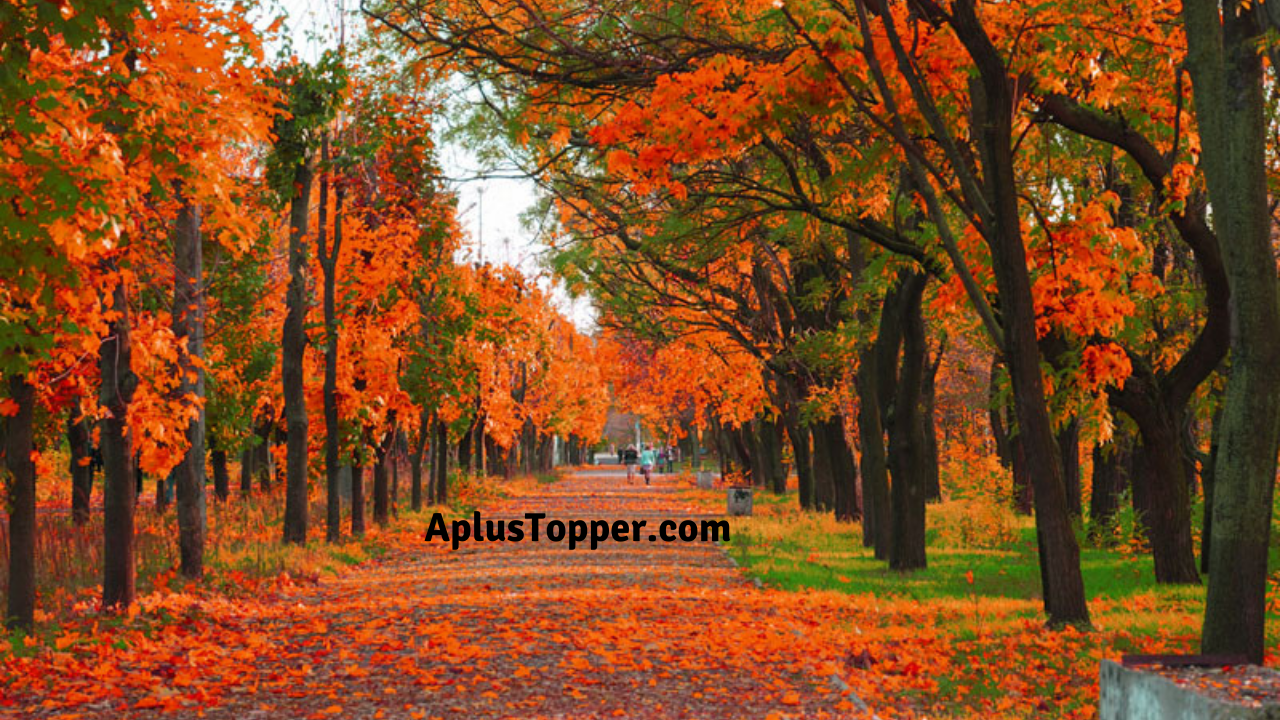
FAQ’s on Autumn Essay
Question 1. Why is autumn the best season?
Answer: Autumn is the favourite season for many of us. This is the season where we can see the falling of colourful leaves from the trees. Also, this season is a very moderate season where we can survive easily since it is neither too cold nor too hot. Therefore, this climate soothes everyone.
Question 2. When does autumn come?
Answer: Autumn comes after summer and before winter. This season is an indicator that winter is coming. The leaves fall off from the trees during this season turning into various colours such as yellow, red or brown.
Question 3. What is the importance of Autumn?
Answer: Autumn addresses the protection of life and its fundamental necessities. During this time, creatures plan for the colder time of year by putting away food and making comfortable hibernation spaces. Ranchers work on their fall gather by gathering a save of yields.
- Picture Dictionary
- English Speech
- English Slogans
- English Letter Writing
- English Essay Writing
- English Textbook Answers
- Types of Certificates
- ICSE Solutions
- Selina ICSE Solutions
- ML Aggarwal Solutions
- HSSLive Plus One
- HSSLive Plus Two
- Kerala SSLC
- Distance Education
Home — Essay Samples — Environment — Autumn — Why Autumn is the Best Season for Me
Why Autumn is The Best Season for Me
- Categories: Autumn
About this sample

Words: 770 |
Updated: 28 November, 2023
Words: 770 | Pages: 2 | 4 min read
Video Version

You May Also Like
- Biodiversity Loss: Ethical Concerns & Human Responsibility
- Megalodon vs. Great White Shark: Comparative Anatomy
- The Importance of Preserving the Amazon Rainforest
- Sustainable Tomorrow: Alternative Energy Sources Future
- The Impact of Air Pollution on Public Health and the Environment
- Carbon Footprint & Supply Chains: Pushing for Sustainability
- Economic Implications of Nationwide Ban on Plastic

Cite this Essay
To export a reference to this article please select a referencing style below:
Let us write you an essay from scratch
- 450+ experts on 30 subjects ready to help
- Custom essay delivered in as few as 3 hours
Get high-quality help

Dr Jacklynne
Verified writer
- Expert in: Environment

+ 120 experts online
By clicking “Check Writers’ Offers”, you agree to our terms of service and privacy policy . We’ll occasionally send you promo and account related email
No need to pay just yet!
Related Essays
1 pages / 486 words
2 pages / 745 words
2 pages / 863 words
5 pages / 2185 words
Remember! This is just a sample.
You can get your custom paper by one of our expert writers.
121 writers online

Still can’t find what you need?
Browse our vast selection of original essay samples, each expertly formatted and styled
Related Essays on Autumn
Autumn, the gradual transition from the scorching days of summer to the chill of winter, holds a special place in my heart. There is an undeniable magic in the air as the world undergoes its slow transformation. Despite the [...]
John Keats’s poem, “To Autumn”, is an ode which is defined as “a lyric poem of some length, usually of a serious or meditative nature and having an elevated style and formal stanza structure.” “To Autumn” has a lot of [...]
Intergovernmental Panel on Climate Change (IPCC). 'Fifth Assessment Report (AR5).' IPCC, 2014.Kwan, M. P., & Wong, M. S. 'Climate Change and Air Quality in Urban Areas: A Review.' Climatic Change, vol. 125, no. 4, 2014, pp. [...]
This is the stop of season 1 episode six of Serial which describes the story of Mrs. Lee getting manually strangled and left in Leakin park alone, putting a boy in prison who later turned into a man, lost his childhood, claimed [...]
Embarking on a journey through nature's most majestic displays of power and beauty, I found myself immersed in an unforgettable thunderstorm experience. The rumbling skies, electrifying lightning, and torrential rain unveiled a [...]
Many places on this planet keep fascinating many of us with their beauty and grand power that nature has offered them. And one such beauty that people visit time and time again to view, is the Niagara Falls, situated in the [...]
Related Topics
By clicking “Send”, you agree to our Terms of service and Privacy statement . We will occasionally send you account related emails.
Where do you want us to send this sample?
By clicking “Continue”, you agree to our terms of service and privacy policy.
Be careful. This essay is not unique
This essay was donated by a student and is likely to have been used and submitted before
Download this Sample
Free samples may contain mistakes and not unique parts
Sorry, we could not paraphrase this essay. Our professional writers can rewrite it and get you a unique paper.
Please check your inbox.
We can write you a custom essay that will follow your exact instructions and meet the deadlines. Let's fix your grades together!
Get Your Personalized Essay in 3 Hours or Less!
We use cookies to personalyze your web-site experience. By continuing we’ll assume you board with our cookie policy .
- Instructions Followed To The Letter
- Deadlines Met At Every Stage
- Unique And Plagiarism Free
Autumn is my Favorite Season
In this personal essay, the writer will express their fondness for the autumn season, describing the sensory experiences, activities, and feelings it evokes. The piece will discuss the aesthetic appeal of autumn, such as the changing leaves and cooler weather, and how these changes influence mood and lifestyle. The essay will also reflect on the cultural and personal significance of autumn, including traditions and memories associated with the season. It aims to provide a personal and descriptive account that resonates with readers who share a similar appreciation for autumn. Also at PapersOwl you can find more free essay examples related to Attention.
How it works
Each person has their own favorite season. Some people like winter, which brings New Years, skiing, snowballing. Others admire the spring, sometimes the awakening of nature from sleep. Sometimes, when streams ring and drops cry. Someone simply adores summer: vacations, swimming in rivers, walks with friends. And I like autumn.
I think autumn is the most beautiful time. The leaves of the trees change their color, if in the summer they were green, now they glow with golden, crimson, orange colors.
Nature is preparing for a long winter sleep, but there are still warm days, it is so good to walk in the autumn park when fallen leaves are barely audible and mysteriously rustling underfoot as if saying goodbye to the past summer.
Fresh air smells like rotten leaves, wet earth. High in the sky, cranes are chirping and flying to hot countries.
Walking in the autumn park, I really like to collect bouquets of fallen colorful leaves.
It turns out such wonderful bright bouquets, which are in no way inferior to bouquets of flowers. I also like to use autumn leaves instead of bookmarks for books.
Most of all, I like autumn because it is the rainiest time, I really like to walk in the rain. When it’s time for long rains, it’s so nice to get into a comfortable chair, cover yourself with a blanket and, listening to the sound of the rain outside the window, read some interesting book, or just dream about something.
Every year our school hosts the Golden Autumn holiday. The assembly hall is decorated with garlands of autumn leaves, and on the tables – gifts of autumn, because autumn is the time for harvesting.
All our poets wrote about autumn, showered it with dozens of epithets, autumn was depicted on their canvases by all great painters, conveying with paints all the splendor of this divine beauty.
Near my house, a rowan grows under the window, how beautiful it is in autumn! When leaves have already flown from all the trees, the mountain ash simply blazes with its clusters of scarlet berries.
I love the time of falling leaves, when the leaves slowly swirling in the air, slowly falling and covering the whole earth with a golden carpet. I also like it when in the fall the loose leaves gathered in a heap are burned. For some reason, the smell of these leaves always evokes in me a feeling of some kind of nagging sadness and sadness, but light and light sadness. I was born in the fall, maybe that’s why I love this most wonderful time of the year with all my heart and soul. I am always looking forward to the onset of this wonderful time, which gives me happiness and joy.
Nothing is quite so remarkable as the change that takes place in the autumn. Where not so long ago we were surrounded by bushes and trees resplendent in their summer greens, we are now living in a world of jumbled hues of orange and gold and rust. Where just days ago the lawn around the house was a well-vacuumed carpet of grass, clipped and tidy, it is now virtually covered over with fallen dried leaves. Autumn lingers like pleasant memories from a good friend’s visit, like the fresh-scrubbed oxygen that a thunderstorm leaves behind. It is a time of change when every morning brings new colors, new smells, and an altered vista. It is a time when even as the pace of change quickens in the natural world, the pace of man slows. It is the season of meandering strolls through multihued glens, through the melancholy fluttering of leaves falling to the ground.
Autumn is a time of introspection when the sniff of drying foliage and loam slow the mind to consider days past, the highs and lows of a life. Every season has its own beauty, but autumn, like spring, brings with it a mood. If spring exults in new life, autumn examines the old; if spring is the anticipation of tomorrow, autumn is a meditation on yesterday. So much of life is a process; so much of it is just paying attention. What good is our stumbling if we never look back to understand why we tripped? What good is a victory if it doesn’t leave us more humble? What good is life itself if tomorrow doesn’t find us better than we were the day before? In the magnificent untidiness of our life-walk, it is necessary to pause beneath the drifting, dying leaves of autumn and examine the grace just spent. I want to learn to pay better attention: to listen, to observe, to learn. Nature never stands still; it is always moving, pressing into the next day. Today’s tree will be taller tomorrow—or it will be fallen, lying dead and rotting in last year’s leaves. Today’s grass, luxuriously pliant and green, will tomorrow be brittle and parched, brown and sharp to the touch. The fawn that accompanies his mother today will next year be taller and on his own—or he may become a hunter’s trophy. Time never stops.
Season passes into season, change inevitably comes. As I gaze out my window, into the trees of Land Park that each day put on new clothes, I feel a sense of urgency. What have I accomplished today? The days continue to tick by; what am I doing that will yield eternal results? The person I pass on the street today will tomorrow be older—or dead. What have I done today so that his tomorrow will be something more than just his being one day older? Have I been kind to those around me, or have I been impatient and rude? Do I expect everyone to be perfect like me? Or do I allow for the imperfections everyone else permits me? Will the world be better—or larger—tomorrow, because of something I’ve done today? Have I filled up each day using the gifts God has graciously entrusted to me? Have I used them or have I squandered them? Some young plants and trees still need to be watered in the autumn. They ask for deep-rooted sustenance to carry them through the dormancy of winter. As I fill the old galvanized bucket with water and carry it to the base of the small tree newly planted in the yard, I notice a few drops leaking from the bottom edge, trailing a glistening path of drips through the drying leaves that carpet the grass. And I realize that when we are born, we are each given a bucketful of days. God fills our bucket to overflowing, pouring into it, as well, all God’s goodness and blessings, gifts and opportunities. As time passes, the days drip out, one by one, until, at our earthly end, the bucket is dry. Our days have run out. Our gifts and opportunities have reached their end. No more. Each of us begins with a bucketful of days. But only God knows how many days are in our bucket. Will we spend them well?
Cite this page
Autumn is My Favorite Season. (2021, May 11). Retrieved from https://papersowl.com/examples/autumn-is-my-favorite-season/
"Autumn is My Favorite Season." PapersOwl.com , 11 May 2021, https://papersowl.com/examples/autumn-is-my-favorite-season/
PapersOwl.com. (2021). Autumn is My Favorite Season . [Online]. Available at: https://papersowl.com/examples/autumn-is-my-favorite-season/ [Accessed: 16 Nov. 2024]
"Autumn is My Favorite Season." PapersOwl.com, May 11, 2021. Accessed November 16, 2024. https://papersowl.com/examples/autumn-is-my-favorite-season/
"Autumn is My Favorite Season," PapersOwl.com , 11-May-2021. [Online]. Available: https://papersowl.com/examples/autumn-is-my-favorite-season/. [Accessed: 16-Nov-2024]
PapersOwl.com. (2021). Autumn is My Favorite Season . [Online]. Available at: https://papersowl.com/examples/autumn-is-my-favorite-season/ [Accessed: 16-Nov-2024]
Don't let plagiarism ruin your grade
Hire a writer to get a unique paper crafted to your needs.

Our writers will help you fix any mistakes and get an A+!
Please check your inbox.
You can order an original essay written according to your instructions.
Trusted by over 1 million students worldwide
1. Tell Us Your Requirements
2. Pick your perfect writer
3. Get Your Paper and Pay
Hi! I'm Amy, your personal assistant!
Don't know where to start? Give me your paper requirements and I connect you to an academic expert.
short deadlines
100% Plagiarism-Free
Certified writers

IMAGES
VIDEO
COMMENTS
Autumn is a visual feast for the senses. As summer fades, trees shed their green garb, revealing a palette of fiery hues. The leaves transform into brilliant shades of crimson, amber, and burnt orange. Walking through a forest or strolling along tree-lined streets, one is greeted by a mesmerizing array of colors.
Reading example essays is the best way to make sense of the tips provided above. Here's an example of a descriptive essay about nature, accompanied by an explanation of its effectiveness. Title: "Autumn's Elegance: Nature's Grand Finale". Autumn, the season of transformation and melancholic beauty, casts its enchanting spell upon the world.
Descriptive Essay About Autumn. The Fall season is a beautiful time of the year, filled with vibrant colors and plenty of. activities. The leaves on the trees begin to change color, transforming from bright greens to. oranges, yellows, and reds. Leaves are seen tumbling down from the sky like little parachutes,
Tactile: Describe the cool, crisp air on your skin or the sensation of walking on crunchy leaves. Emotions and Mood: Reflect on the emotions and mood associated with autumn. It’s a season of change, nostalgia, and transition. Capture these feelings in your description.
A descriptive essay is a written account describing something or an experience. At first, it may feel like something you don’t have to put much time into teaching. Just throw in some adjectives and you’re good to go! Yet, there’s more to it than that. Let’s dive into how I taught descriptive writing during the fall this past week.
Long Essay on Autumn Season 600+ Words in English. The Autumn season begins before the beginning of winters as a rule in the long stretch of September. In particular, the fall season ranges from September and November on the northern side of the equator. This season is otherwise called the fall season in numerous nations.
Autumn is a time for the closeness of others to keep out the chill of the morning and the starry-eyed darkness of the night. The colors are astonishing. No longer does green dwell the trees. It seems the entire world is on fire. The bright yellow has mingled with the orange to create small flames, flickering from the branches of trees.
Sample. Details. "Why autumn is the best season" is a sentiment I've held for a long time. Autumn is such a sensational time of year. There are multitudinous festivities to engage in. The weather is lovely, the way the leaves change colors is very appealing to me, the fair is here, and everybody is hyped for the football season.
Introduction Autumn, also known as fall, is a season that ushers in a symphony of vibrant colors, crisp air, and a subtle sense of nostalgia. As nature begins its transformation, the landscape becomes a captivating tapestry of reds, oranges, and golds. In this descriptive essay, we will explore the enchanting beauty and sensory delights of autumn.
The essay will also reflect on the cultural and personal significance of autumn, including traditions and memories associated with the season. It aims to provide a personal and descriptive account that resonates with readers who share a similar appreciation for autumn. Also at PapersOwl you can find more free essay examples related to Attention.